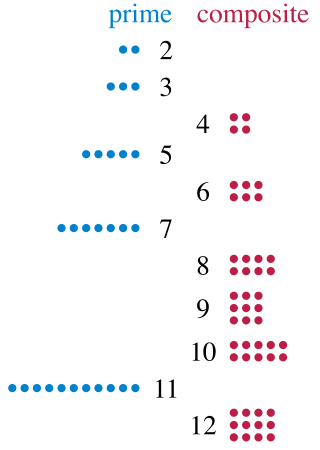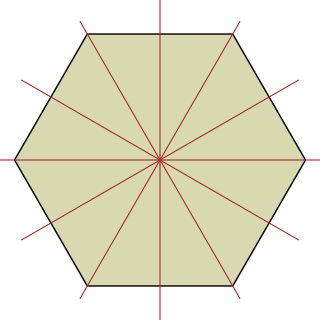Definition
The Dwork family is given by the equations
for all .
In algebraic geometry, a Dwork family is a one-parameter family of hypersurfaces depending on an integer n, studied by Bernard Dwork. Originally considered by Dwork in the context of local zeta-functions, such families have been shown to have relationships with mirror symmetry and extensions of the modularity theorem. [1]
The Dwork family is given by the equations
for all .

In mathematics, a group is a non-empty set with an operation that satisfies the following constraints: the operation is associative, has an identity element, and every element of the set has an inverse element.

A prime number is a natural number greater than 1 that is not a product of two smaller natural numbers. A natural number greater than 1 that is not prime is called a composite number. For example, 5 is prime because the only ways of writing it as a product, 1 × 5 or 5 × 1, involve 5 itself. However, 4 is composite because it is a product (2 × 2) in which both numbers are smaller than 4. Primes are central in number theory because of the fundamental theorem of arithmetic: every natural number greater than 1 is either a prime itself or can be factorized as a product of primes that is unique up to their order.

In mathematics and physics, a vector space is a set whose elements, often called vectors, may be added together and multiplied ("scaled") by numbers called scalars. Scalars are often real numbers, but can be complex numbers or, more generally, elements of any field. The operations of vector addition and scalar multiplication must satisfy certain requirements, called vector axioms. The terms real vector space and complex vector space are often used to specify the nature of the scalars: real coordinate space or complex coordinate space.

In mathematics, the Hodge conjecture is a major unsolved problem in algebraic geometry and complex geometry that relates the algebraic topology of a non-singular complex algebraic variety to its subvarieties.
In mathematics, the Weil conjectures were highly influential proposals by André Weil (1949). They led to a successful multi-decade program to prove them, in which many leading researchers developed the framework of modern algebraic geometry and number theory.

Commutative algebra, first known as ideal theory, is the branch of algebra that studies commutative rings, their ideals, and modules over such rings. Both algebraic geometry and algebraic number theory build on commutative algebra. Prominent examples of commutative rings include polynomial rings; rings of algebraic integers, including the ordinary integers ; and p-adic integers.

Geometry of numbers is the part of number theory which uses geometry for the study of algebraic numbers. Typically, a ring of algebraic integers is viewed as a lattice in and the study of these lattices provides fundamental information on algebraic numbers. The geometry of numbers was initiated by Hermann Minkowski (1910).

In algebra, ring theory is the study of rings—algebraic structures in which addition and multiplication are defined and have similar properties to those operations defined for the integers. Ring theory studies the structure of rings, their representations, or, in different language, modules, special classes of rings, as well as an array of properties that proved to be of interest both within the theory itself and for its applications, such as homological properties and polynomial identities.
In geometry, a hypersurface is a generalization of the concepts of hyperplane, plane curve, and surface. A hypersurface is a manifold or an algebraic variety of dimension n − 1, which is embedded in an ambient space of dimension n, generally a Euclidean space, an affine space or a projective space. Hypersurfaces share, with surfaces in a three-dimensional space, the property of being defined by a single implicit equation, at least locally, and sometimes globally.

In mathematics, tropical geometry is the study of polynomials and their geometric properties when addition is replaced with minimization and multiplication is replaced with ordinary addition:
In algebraic geometry, a finite morphism between two affine varieties is a dense regular map which induces isomorphic inclusion between their coordinate rings, such that is integral over . This definition can be extended to the quasi-projective varieties, such that a regular map between quasiprojective varieties is finite if any point like has an affine neighbourhood V such that is affine and is a finite map.
In mathematics, a Noetherian topological space, named for Emmy Noether, is a topological space in which closed subsets satisfy the descending chain condition. Equivalently, we could say that the open subsets satisfy the ascending chain condition, since they are the complements of the closed subsets. The Noetherian property of a topological space can also be seen as a strong compactness condition, namely that every open subset of such a space is compact, and in fact it is equivalent to the seemingly stronger statement that every subset is compact.
In mathematics, the Gauss–Manin connection is a connection on a certain vector bundle over a base space S of a family of algebraic varieties . The fibers of the vector bundle are the de Rham cohomology groups of the fibers of the family. It was introduced by Yuri Manin (1958) for curves S and by Alexander Grothendieck (1966) in higher dimensions.
In mathematics, crystalline cohomology is a Weil cohomology theory for schemes X over a base field k. Its values Hn(X/W) are modules over the ring W of Witt vectors over k. It was introduced by Alexander Grothendieck (1966, 1968) and developed by Pierre Berthelot (1974).
In mathematics, Hochschild homology (and cohomology) is a homology theory for associative algebras over rings. There is also a theory for Hochschild homology of certain functors. Hochschild cohomology was introduced by Gerhard Hochschild (1945) for algebras over a field, and extended to algebras over more general rings by Henri Cartan and Samuel Eilenberg (1956).
In algebraic geometry, flips and flops are codimension-2 surgery operations arising in the minimal model program, given by blowing up along a relative canonical ring. In dimension 3 flips are used to construct minimal models, and any two birationally equivalent minimal models are connected by a sequence of flops. It is conjectured that the same is true in higher dimensions.
In algebraic geometry, the minimal model program is part of the birational classification of algebraic varieties. Its goal is to construct a birational model of any complex projective variety which is as simple as possible. The subject has its origins in the classical birational geometry of surfaces studied by the Italian school, and is currently an active research area within algebraic geometry.

Representation theory is a branch of mathematics that studies abstract algebraic structures by representing their elements as linear transformations of vector spaces, and studies modules over these abstract algebraic structures. In essence, a representation makes an abstract algebraic object more concrete by describing its elements by matrices and their algebraic operations. The theory of matrices and linear operators is well-understood, so representations of more abstract objects in terms of familiar linear algebra objects helps glean properties and sometimes simplify calculations on more abstract theories.
In mathematical genetics, a genetic algebra is a algebra used to model inheritance in genetics. Some variations of these algebras are called train algebras, special train algebras, gametic algebras, Bernstein algebras, copular algebras, zygotic algebras, and baric algebras. The study of these algebras was started by Ivor Etherington (1939).
In algebraic geometry, the Witten conjecture is a conjecture about intersection numbers of stable classes on the moduli space of curves, introduced by Edward Witten in the paper Witten (1991), and generalized in Witten (1993). Witten's original conjecture was proved by Maxim Kontsevich in the paper Kontsevich (1992).
p. 545